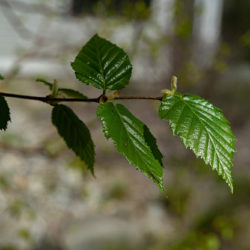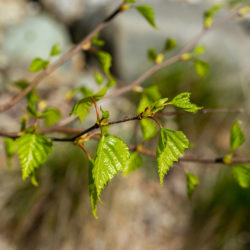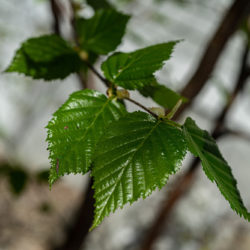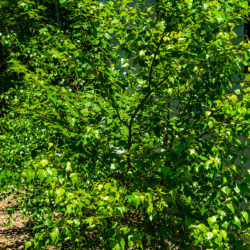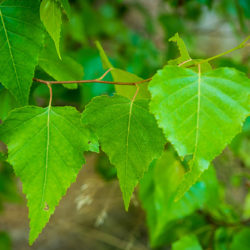Etymology
Betula is Latin for tree whose bark is used for writing upon; populifolia is Latin for leaves similar to a poplar.
Native Habitat
Medium to wet, well-drained, sandy or rocky loams in full sun to part shade.
Garden Uses
Specimen or grove plantings. Prune for shaping only after sap has stopped flowing in the summer, or in early winter. Branches are slim and flexible, and can bend to the ground under snow load without breaking. Limbs or suckers pruned in winter can be used for “pea brush” the next summer.
Overview
This birch adds winter interest with its non-peeling, dull white bark, and distinctive black chevron formations below each branch base. It is a relatively short lived birch, typically growing to 20 to 40 feet, and often growing in a multi-trunked form, sometimes suckering. Its canopy is typically narrow. It grows well in full sun to part-shade and prefers moist but well-drained soils, but will tolerate some dryness with afternoon shade.
Leaves and Stems
Leaves emerge after catkins, and are simple, alternate, glossy green, and an unusual long, triangular, tapered shape, 3 inches long, and double toothed. They tremble in the wind like an aspen and yellow in autumn. Bark is thin, smooth, dull white and non-peeling in young trees, and darkens as the tree ages. Twigs have a rougher, warty appearance.
Flowers
Yellow or green catkins emerge before leaves in May. Both male and female catkins are on the same tree (monoecious). Male catkins are single, hanging up to 4 inches long at branch tips. Female catkins are erect, cylindrical, wider, and shorter (1/2 inch long), and grow from new, spur-like lateral twigs on the same branches as the males.
Fruit/Seed
Female catkins become drooping, cone-like clusters about 1/2 inch long, composed of winged nutlets, which dry from green to tan or brown in late summer.
Wildlife Associates
As with all birches, it is a host to many insect larvae, beneficial (butterflies, such as tiger swallowtail) or destructive (bronze birch borer). Seeds are important food for birds and small mammals. Thickets provide cover for many species.
Propagation
Can be seed grown; collect catkins directly into a bag, while they are still green enough to hold together, and provide one month cold stratification.
Ethnobotanical Uses
The wood of this tree is easily worked, and can be used for small, turned items like spools. It’s also used for firewood.
Garden Location
Library Garden, Performance Hall Garden, Teaching Garden, West Woods, South Woods, North Woods (see garden map)
Sources
Lady Bird Johnson Wildflower Center
Plant Profile by Kate O’Dell

